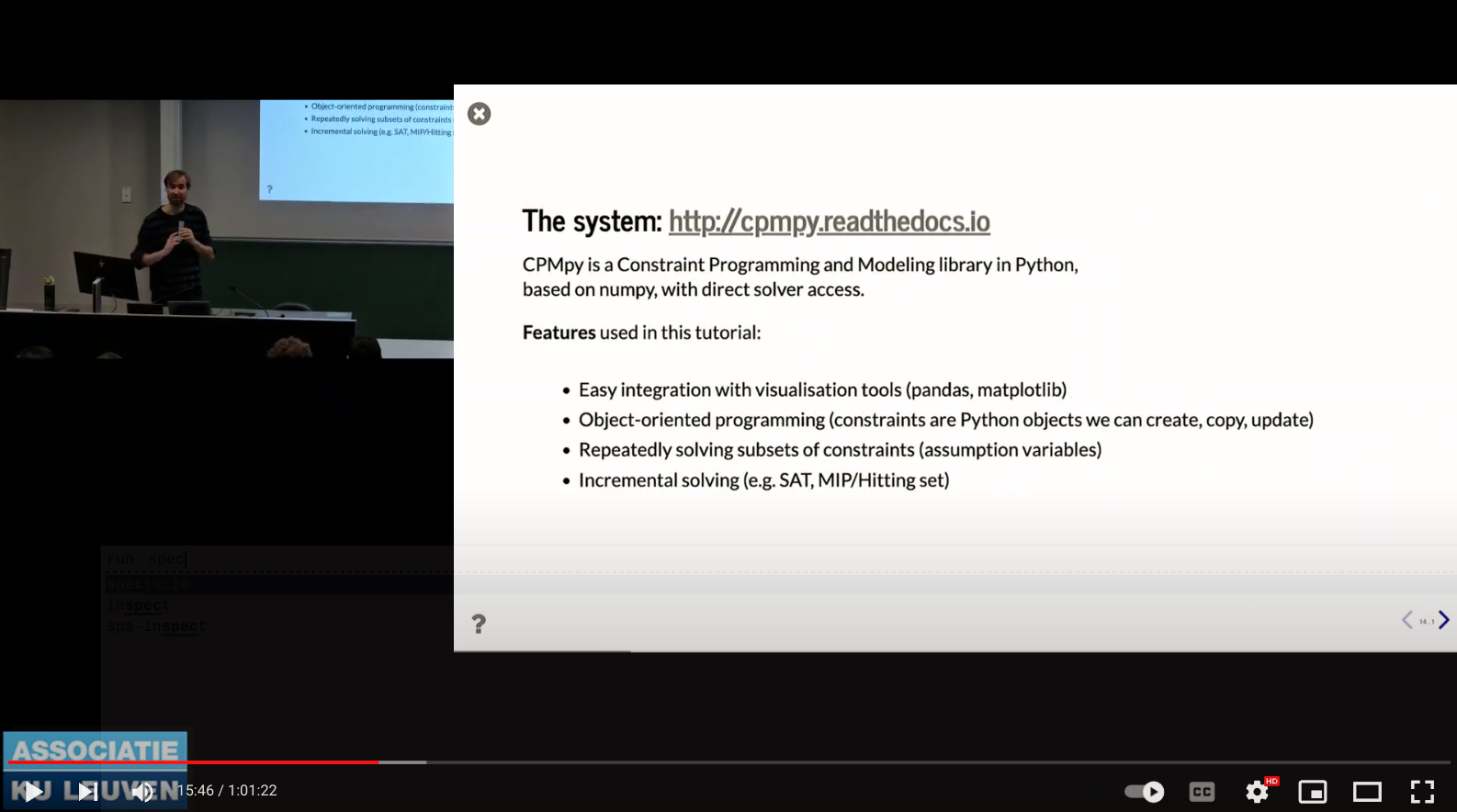This repository contains the code and runnable notebook for our Explainable Constraint Solving tutorials and talks.
- Tutorial notebook (PDF will be added later): https://github.com/CPMpy/XCP-explain/blob/main/ecai2024_presentation.ipynb
- Part 1 Google Colab: https://colab.research.google.com/github/CPMpy/XCP-explain/blob/main/ecai2024_practice_part1.ipynb
- Part 2 Google Colab: : https://colab.research.google.com/github/CPMpy/XCP-explain/blob/main/ecai2024_practice_part2.ipynb
- Part 3 Google Colab: https://colab.research.google.com/github/CPMpy/XCP-explain/blob/main/ecai2024_practice_part3.ipynb
Explainable constraint solving is a sub-field of explainable AI (XAI) concerned with explaining constraint (optimization) problems. Although constraint models are explicit: they are written down in terms of individual constraints that need to be satisfied, and the solution to such models can be non-trivial to understand.
Driven by the use-case of nurse scheduling, we demonstrate the type of questions a user can have about (non)-solutions, as well as reviewing what kind of computational tools are available today to answer such questions. We cover classical methods such as MUS/MCS extraction, and more recent advances in the field such as step-wise explanations, constraint relaxation methods, and counterfactual solutions. We demonstrate and give special attention to techniques that we have successfully (re-)implemented on top of the CPMpy constraint-solving library, which can be readily used today.
The following presentations are available:
- ACP 2024 Winter School lecture: Notebook PDF slides YouTube video
- CP 2023 tutorial: Notebook HTML slides PDF slides YouTube video
The slide-show can be viewed from browser by opening the HTML version and using
Spaceto go to the next slide.
Here is the tutorial video for convenience:

To run the .ipynb yourself, makes sure you install the following packages:
- CPMpy (>= v0.9.17)
- jupyter
- rise (to make the slideshow)
- faker (to create fake names for nurses)
- pandas (for visualizations)
- matplotlib (for visualizations)
A one-liner to install pip-packages:
pip install -r requirements.txtOptionally, you can install the Gurobi MIP solver for better performance of algorithms relying on incremental solving:
Note that for Gurobi, you will need a license in order to make full use of its power.
pip install gurobipy.
├── Benchmarks # Nurse scheduling instances
├── explanations
│ ├── __init__.py
│ ├── counterfactual.py # Counterfactual explanations [1]
│ ├── marco_mcs_mus.py # MARCO enumeration algorithm [2]
│ ├── stepwise # Fork of the step-wise explanations repo [3]
│ └── subset.py # Code to find all kinds of subsets of constraints
├── factory.py # Wrapper for nsp
├── hands-on-tutorial slides.pdf # Exectued version of the slides
├── hands-on-tutorial.ipynb # Runnable version of the slides
├── hands-on-tutorial.slides.html # .html version of the executed slides
├── img # Images used in the tutorial
├── read_data.py # Helper functions to read and wrangle NSP data
└── visualize.py # Helper functions for visualization of constraints and solutions@software{bleukx2024_tutorial,
author = {Ignace Bleukx and
Guns, Tias and
Tsouros, Dimos},
title = {{Explainable Constraint Solving: A hands-on
tutorial}},
month = feb,
year = 2024,
publisher = {Zenodo},
version = {v1.0},
doi = {10.5281/zenodo.10694139},
url = {https://doi.org/10.5281/zenodo.10694139}
}[1] Korikov, A., & Beck, J. C. (2021). Counterfactual explanations via inverse constraint programming. In 27th International Conference on Principles and Practice of Constraint Programming (CP 2021). Schloss Dagstuhl-Leibniz-Zentrum für Informatik.
[2] Liffiton, M.H., & Malik, A. (2013). Enumerating infeasibility: Finding multiple MUSes quickly. In Proceedings of the 10th International Conference on Integration of AI and OR Techniques in Constraint Programming (CPAIOR 2013) (pp. 160–175)
[3] Bleukx, I., Devriendt, J., Gamba, E., Bogaerts B., & Guns T. (2023). Simplifying Step-wise Explanation Sequences. In International Conference on Principles and Practice of Constraint Programming 2023